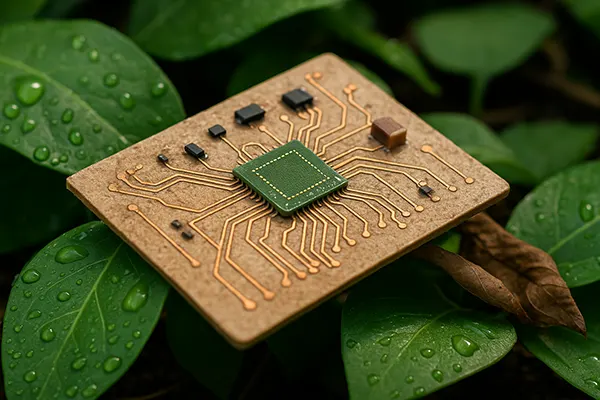
Biodegradable Electronics: Gadgets That Disappear Without Harming the Environment
Biodegradable electronics are emerging as a promising solution to one of the most pressing problems of our time — electronic waste. With millions of tonnes of e-waste produced each year, researchers and engineers are developing devices that can naturally decompose after their useful life ends. These innovations could transform how we manufacture, use, and dispose of technology, reducing environmental damage and conserving valuable resources.
The Rise of Biodegradable Electronics
The demand for sustainable alternatives to traditional electronics has driven rapid progress in biodegradable materials. Scientists are creating components made from natural polymers, silk proteins, cellulose, and even rice paper, which can break down harmlessly in soil or water. These materials can replace plastics and metals commonly found in electronic devices, significantly reducing their long-term environmental footprint.
Universities and research institutes worldwide are collaborating with industry partners to design fully functional gadgets that naturally dissolve after use. For example, transient circuits, sensors, and microchips have been developed that maintain their performance during use but disintegrate under specific conditions, such as exposure to water or heat. This approach helps prevent the accumulation of hazardous substances in landfills.
By incorporating biodegradable components into consumer products, manufacturers could reduce the need for costly recycling processes. This shift would also encourage more responsible production cycles, aligning with global efforts to promote circular economies and sustainable resource management in the technology sector.
Current Applications and Research
Biodegradable electronics are currently being tested in various sectors, including medical, environmental, and agricultural industries. One promising field is temporary medical implants that dissolve inside the body after performing their function, eliminating the need for surgical removal and reducing medical waste. These devices can monitor vital signs, deliver medication, or support tissue healing before safely degrading.
In environmental monitoring, single-use sensors made from biodegradable materials can be deployed to track soil moisture, water quality, or pollution levels. Once they complete their tasks, they break down naturally, avoiding the contamination that conventional sensors could cause if left behind. This makes them especially valuable for large-scale field studies and remote locations.
Researchers are also exploring flexible and printable electronics using biodegradable inks and substrates. These can be applied to smart packaging, wearable devices, or disposable diagnostic tools. Their low-cost production and eco-friendly disposal offer significant potential for reducing the carbon footprint of short-lifecycle electronics.
Challenges in Developing Biodegradable Gadgets
Despite their promise, biodegradable electronics still face several technical and commercial challenges. One of the main obstacles is achieving the same level of durability and performance as conventional electronics while ensuring they can decompose after use. Balancing functionality with biodegradability requires extensive material science innovation and testing.
Another barrier is large-scale manufacturing. Producing biodegradable components at industrial levels remains costly and complex. Specialised equipment and stringent production conditions are often required to maintain the stability of biodegradable materials during fabrication, which limits their widespread adoption in consumer markets.
There are also regulatory and safety concerns. Biodegradable devices must meet strict performance standards while proving they leave no harmful residues after decomposition. This requires comprehensive life cycle assessments and certification processes, which can delay their commercial introduction.
Industry Efforts and Innovation
Several tech companies and start-ups are investing heavily in research to overcome these barriers. Some are developing hybrid designs that combine biodegradable substrates with small amounts of recyclable materials, striking a balance between durability and environmental responsibility. These hybrid devices can maintain performance standards while reducing overall waste.
Collaborations between universities and manufacturers are accelerating innovation. Shared research initiatives and open-source design models allow rapid testing and refinement of biodegradable technologies. Governments are also providing grants and policy incentives to encourage sustainable product development in the electronics sector.
Public awareness campaigns about e-waste are increasing consumer demand for greener products. This demand pushes manufacturers to consider biodegradable alternatives as part of their long-term sustainability strategies, potentially speeding up the transition from traditional to eco-friendly electronics.

The Future of Sustainable Electronics
Experts predict that biodegradable electronics will become more common within the next decade, especially as production costs decrease and regulations tighten around e-waste. By 2030, biodegradable components could be standard in many consumer devices, including wearable health monitors, smart packaging, and disposable medical sensors.
Educational institutions are introducing courses and research programmes focused on green electronics, preparing a new generation of engineers to work on sustainable technologies. This academic investment will ensure that innovation continues, fostering breakthroughs that make biodegradable electronics more efficient and affordable.
Ultimately, widespread adoption of biodegradable electronics could transform the tech industry’s environmental footprint. By designing products that safely return to nature after use, humanity could significantly reduce pollution, conserve resources, and create a cleaner future for the next generations.
Outlook and Global Impact
The global shift towards biodegradable electronics aligns with international goals to reduce electronic waste and carbon emissions. Nations across Europe, Asia, and North America are implementing stricter recycling and waste management regulations, which will likely accelerate the adoption of eco-friendly technologies in commercial markets.
Companies embracing biodegradable electronics can gain a competitive advantage by aligning with sustainability expectations from regulators and consumers. This will also drive innovation in supply chains, material sourcing, and product design, contributing to a broader transformation of the electronics industry.
If supported by continued research funding, industry collaboration, and regulatory frameworks, biodegradable electronics could become a cornerstone of sustainable development. Their success would represent a major step towards reconciling technological advancement with environmental responsibility.




